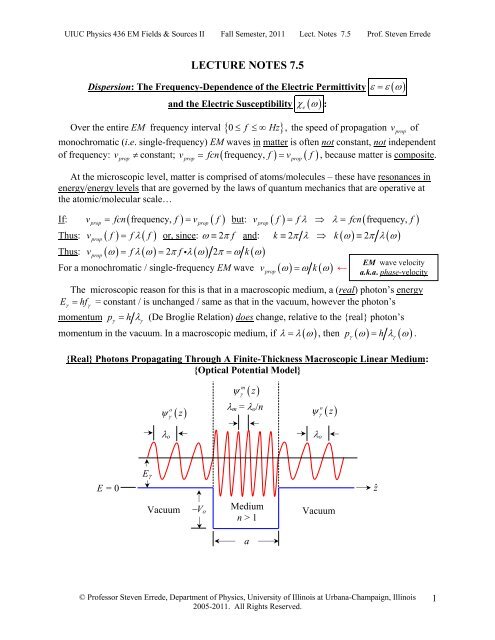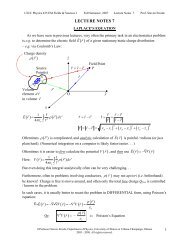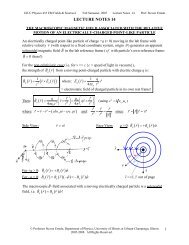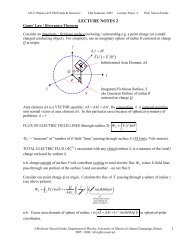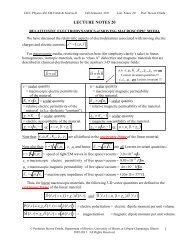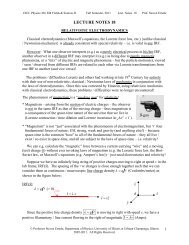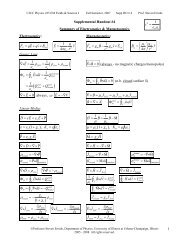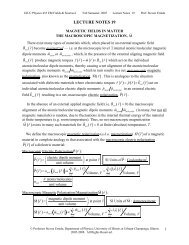Lecture Notes 07.5 - University of Illinois High Energy Physics
Lecture Notes 07.5 - University of Illinois High Energy Physics
Lecture Notes 07.5 - University of Illinois High Energy Physics
Create successful ePaper yourself
Turn your PDF publications into a flip-book with our unique Google optimized e-Paper software.
UIUC <strong>Physics</strong> 436 EM Fields & Sources II Fall Semester, 2011 Lect. <strong>Notes</strong> 7.5 Pr<strong>of</strong>. Steven ErredeLECTURE NOTES 7.5Dispersion: The Frequency-Dependence <strong>of</strong> the Electric Permittivity ε = ε( ω)and the Electric Susceptibility χe( ω ) :0 ≤ ≤∞ , the speed <strong>of</strong> propagation vprop<strong>of</strong>monochromatic (i.e. single-frequency) EM waves in matter is <strong>of</strong>ten not constant, not independent<strong>of</strong> frequency: vprop≠ constant; vprop= fcn( frequency, f ) = vprop( f ) , because matter is composite.Over the entire EM frequency interval { f Hz}At the microscopic level, matter is comprised <strong>of</strong> atoms/molecules – these have resonances inenergy/energy levels that are governed by the laws <strong>of</strong> quantum mechanics that are operative atthe atomic/molecular scale…If: vprop= fcn( frequency, f ) = vprop( f ) but: vprop( f ) = fλ ⇒ λ = fcn( frequency, f )Thus: vprop( f ) = fλ( f ) or, since: ω ≡ 2πf and: k ≡ 2π λ ⇒ k ( ω) ≡ 2π λ( ω)Thus: vprop( ω) = fλ( ω) = 2π fiλ( ω) 2π = ω k( ω)For a monochromatic / single-frequency EM wave v ( ω) = ω k( ω)←The microscopic reason for this is that in a macroscopic medium, a (real) photon’s energyEγ= hfγ= constant / is unchanged / same as that in the vacuum, however the photon’smomentum pγ= h λγ(De Broglie Relation) does change, relative to the {real} photon’sλ λ ω p ω = h λ ω .momentum in the vacuum. In a macroscopic medium, if = ( ) , then ( ) ( ){Real} Photons Propagating Through A Finite-Thickness Macroscopic Linear Medium:{Optical Potential Model}λ m = λ o /npropooψ ( z)ψγ ( z)γψmγ( z)γEM wave velocitya.k.a. phase-velocityγλ oλ oE = 0E γẑVacuum−V oMediumn > 1Vacuuma© Pr<strong>of</strong>essor Steven Errede, Department <strong>of</strong> <strong>Physics</strong>, <strong>University</strong> <strong>of</strong> <strong>Illinois</strong> at Urbana-Champaign, <strong>Illinois</strong>2005-2011. All Rights Reserved.1
UIUC <strong>Physics</strong> 436 EM Fields & Sources II Fall Semester, 2011 Lect. <strong>Notes</strong> 7.5 Pr<strong>of</strong>. Steven ErredeMacroscopically, the frequency-dependence <strong>of</strong> the wavelength λ λ( ω)( ) = 2π λ( ω), and linear momentum ( )= , or wavenumberk ωp ω associated with macroscopic EM wavespropagating in a macroscopic, linear/homogeneous/isotropic medium arises from the frequencydependence<strong>of</strong> the macroscopic electric permittivity ε ( ω ) (or equivalently the electricsusceptibility χe( ω ) since:ε ω = ε 1+ χ ω .( ) o( e( ))The frequency dependence <strong>of</strong> the macroscopic electric permittivity ε ( ω ) is known as dispersion;a medium that has ε ≠ constant with varying frequency is known as a dispersive medium.For non-magnetic/non-conducting linear/homogeneous/isotropic media, the index <strong>of</strong> refraction= . Thus if ε = ε( ω) = εo( 1+ χe( ω)) then n( ω) ε( ω) εon ε ε o= .For a wave packet (= a group {= superposition/linear combination} <strong>of</strong> waves <strong>of</strong> many frequencies– as explained by Mssr. Fourier), the envelope <strong>of</strong> the wave packet travels with (in general,frequency-dependent) group velocity:vgroup( ω)( ω)" "dω1 ⎡dk⎤≡ = = ⎢ ⎥dk ( ω) dk ( ω)dω ⎣ dω⎦A propagating wave packet: vp( ω) = vphase( ω) = ω k( ω)( ) ( ) ( )−1vgω = vgroupω ≡⎡dk ω dω⎤−⎣ ⎦1If the phase velocity vp( ω) ω k( ω)−1( ω) = ⎡ ( ω) ω⎤≠ ( ω)v dk d vgroup= is frequency dependent, and⎣ ⎦ phase{e.g. as in the case for surface waves on water, wherevp= 2vg} the exact relationship between vphaseand vgroupdepends on the detailed nature <strong>of</strong> themedium (as we shall soon see. . . ).Note that energy carried by a wave packet travels at the group velocity, vgroupand not at thephase velocity vphase. Note that in certain circumstances, vphasecan exceed c {= speed <strong>of</strong> light inthe vacuum} but in these situations, no energy (and/or information) is transmitted – these aretransmitted at vgroup< c always, by causality… A physical/mechanical example: calculate thephase velocity <strong>of</strong> the intersection point <strong>of</strong> the two halves <strong>of</strong> a scissors as the blades <strong>of</strong> thescissors are closed. {Ans:vscissorsp→∞!!!}2© Pr<strong>of</strong>essor Steven Errede, Department <strong>of</strong> <strong>Physics</strong>, <strong>University</strong> <strong>of</strong> <strong>Illinois</strong> at Urbana-Champaign, <strong>Illinois</strong>2005-2011. All Rights Reserved.
UIUC <strong>Physics</strong> 436 EM Fields & Sources II Fall Semester, 2011 Lect. <strong>Notes</strong> 7.5 Pr<strong>of</strong>. Steven ErredeAn Important Detail:Physically, the phase velocity vphase( ω) ≡ ω k( ω)= a single point on the ω vs. ( )whereas the group velocity v ( ω) ≡ " dω dk( ω)"= the slope <strong>of</strong> the ω vs. ( )groupk ω curve,k ω curve:← Technically, making this plot is wrong !!!Why is this plot technically wrong ???Because ω is the independent variable {always plotted on the axis <strong>of</strong> abscissas (i.e. the x-axis)}and k ( ω)is the dependent variable {always plotted on the axis <strong>of</strong> ordinates (i.e. the y-axis)}Thus, the technically correct way is to plot k ( ω ) vs. ω : {i.e. k depends on ω , not vice-versa!}Then: v ( ω)group( ω) ⎞ ⎡dk( ω)⎛dk⎤≡ 1 ⎜ ⎟=⎢ ⎥⎝ dω⎠ ⎣ dω⎦−1i.e. vgroup( ω) ≡ { k( ω)vs ω}1 slope <strong>of</strong> . graph :© Pr<strong>of</strong>essor Steven Errede, Department <strong>of</strong> <strong>Physics</strong>, <strong>University</strong> <strong>of</strong> <strong>Illinois</strong> at Urbana-Champaign, <strong>Illinois</strong>2005-2011. All Rights Reserved.3
UIUC <strong>Physics</strong> 436 EM Fields & Sources II Fall Semester, 2011 Lect. <strong>Notes</strong> 7.5 Pr<strong>of</strong>. Steven ErredeDispersion Phenomena in Linear DielectricsIn a non-conducting, linear, homogeneous, isotropic medium there are no free electrons(i.e. ρfree ( r ) = 0 ). Atomic electrons are permanently bound to nuclei <strong>of</strong> atoms comprising themedium. ⇒∃ no preferential direction / no preferential directions in such an {isotropic} medium.Suppose each atomic electron (charge –e) in a dielectric is displaced by a small distance r E r .from its equilibrium position, e.g. by application <strong>of</strong> a static electric field ( )The resulting macroscopic electric polarization (aka electric dipole moment per unit volume) is: 3Ρ ( r) = nep( r)where: n e = (atomic) electron number density (#e m ) p r = −er{here}, where r is theand the {induced} atomic/molecular electric dipole moment is: ( ){vector} displacement <strong>of</strong> the atomic electron from its equilibrium { E = 0} position. Ρ r = n p r =−n erThus: ( ) ( )eeThe atomic electrons are each elastically bound to their equilibrium positions with a force constant ke. The force equation for each atomic electron is thus: Fe( r) =− eE( r)= kerThe static polarization is therefore given by: ( ) ( ) ( )2 ⎛−eE r ⎞ neeΡ r = nep r =− neer =− nee =+ E r⎜ k ⎟eke⎝ ⎠However, if the E ikz ( −ωt)-field varies with time, i.e. E = E( r,t)= E oee.g. due to amonochromatic EM plane wave incident on an atom, the above relation is incorrect !A more correct {“semi-classical”} way to treat this situation is to consider the bound atomicelectrons as classical, damped, forced harmonic oscillators, as mathematically described by thefollowing differential equation:mr e+ meγr + kr e=−eE ( r ) ← inhomogeneous 2 nd -order differential equation2∂ r () t ∂r()t me + m2 eγ+ ker n.b. we have neglected the() t =−eE( r,t)← ∂t ∂t ev × B eE term here...ma e( )( )Velocity-dependentdamping termγ ≡ damping constantPotential Force(binding <strong>of</strong> atomicelectrons to atom)meDriving Force= electron mass = 9.1×10−31kgSuppose the driving / forcing term varies sinusoidally/is harmonic/periodic in time with iωtF r, t =− eE r,t =−eE e −i tr because E ω( r,t) = E e − rˆ.angular frequency ω , i.e. ( ) ( ) ˆn.b. The electric field E is now complex E .eoo4© Pr<strong>of</strong>essor Steven Errede, Department <strong>of</strong> <strong>Physics</strong>, <strong>University</strong> <strong>of</strong> <strong>Illinois</strong> at Urbana-Champaign, <strong>Illinois</strong>2005-2011. All Rights Reserved.
UIUC <strong>Physics</strong> 436 EM Fields & Sources II Fall Semester, 2011 Lect. <strong>Notes</strong> 7.5 Pr<strong>of</strong>. Steven ErredeThen the inhomogeneous force equation becomes:In the steady state, we have:i tmr − ω+ mγr + kr =−eEe rˆ with ( ) ( ) ˆe e e oi tmr − ω+ mγr + kr =−eEe rˆe e e or t = r t r .Since r physically represents the {vector} spatial displacement <strong>of</strong> each atomic electron from itsequilibrium { E = 0i ω r t = r ω e − t r r t is now complex}.} position, then: ( ) ( ) ˆ {n.b. ( )oThus:i tmr − ω+ mγr + kr =−eEe rˆe e e o2∂ r ( t) ∂r( t) me + m ,2 eγ+ ker t =−eE r t∂t∂t−mωre ωe2 −i toeo() ( )−i t− iωmγre ωi t+ kre − ω2( ω ω γ)e om − k + i m r= eE e e e o oi t=−eE e − ωoDivide this equation through by m :Define:2⎛ k ⎞eω0≡ ⎜ ⎟⎝me⎠2 2Then: ( ω ω γω)e⎛2⎛ k ⎞ ⎞eeω − ⎜ ⎟+ iωγro= E⎜ m ⎟⎝ ⎝ e ⎠ ⎠ mekeor: ω0≡ = characteristic/natural resonance {angular} frequency.m⎛ e ⎞− + i r =⎜ ⎟E⎝ ⎠0 o omee⎛ e ⎞⎜ Em ⎟o =⎝ ⎠=⎡⎣ω − ω0+ iγω⎤⎦e or: ro( ω) 2 2 {n.b. Ρ is now complex and frequency-dependent!!!}iωtNow: Ρ ( rt , ) =− ner( t) =−ner( ω) e − rˆe e ooAtomic electron spatialdisplacement amplitude{n.b. complex!}Thus: ( rt)2e iωt( )( ˆo )e2−n⎛e⎞ee −neE e rm⎜ m ⎟Ρ ,⎝ ⎠ = =+Ert ,2 2 2 2⎣⎡ω − ω0 + iγω⎦ ⎤⎣⎡ω0−ω −iγω⎦⎤( )⇐n.b. Note the re-ordering <strong>of</strong>terms in the denominatorω = : ( ω 0)For 0⎛2 2e ⎞en⎛e⎞⎜ e2m ⎟ ⎜em ⎟⎝ ⎠ ⎝ e⎠⎛ne⎞e2 o o oωk0⎛ e ⎞ ke⎜⎝ ⎠m ⎟enΡ = = Er ˆ= Er ˆ=⎜ ⎟Er ˆ ⇐Note also that the phase <strong>of</strong> {complex} ( ω) lags behind E ( ω)by a phase angle <strong>of</strong>:Ρ ⎝⎠Static polarization Ρ ( ω = 0)depends on the {angular} frequency ω – i.e. Ρ ( ω) is in-phase with E φΡ( ω)⎡Im( Ρ( r,t)1) ⎤ ⎡1 γω ⎤−−= tan ⎢ ⎥ = tan ⎢ ⎥ ⇐2 2⎢Re( Ρ( r,t)) ⎥ ⎢⎣( ω0−ω⎣⎦) ⎥⎦n.b. The damping constant γhas the same units as ω :radians/sec© Pr<strong>of</strong>essor Steven Errede, Department <strong>of</strong> <strong>Physics</strong>, <strong>University</strong> <strong>of</strong> <strong>Illinois</strong> at Urbana-Champaign, <strong>Illinois</strong>2005-2011. All Rights Reserved.5
UIUC <strong>Physics</strong> 436 EM Fields & Sources II Fall Semester, 2011 Lect. <strong>Notes</strong> 7.5 Pr<strong>of</strong>. Steven ErredekeWhen: ω < ω0= , φ Ρ> 0 ⇒ Ρ klags E . When:eω > ω0= , φ Ρ< 0 ⇒Ρ leads E .memeFrom the above formula, note that if the damping constant, γ = 0 then φ Ρ= 0 , the electricΡ ωbecause if 0 ImΡ r, t = 0,polarization ( )is then always in-phase with ( ) E ω( )γ = , then ( )i.e. the electric polarization Ρ ( ω)is purely real! Physically, a damping constant <strong>of</strong> γ = 0 meansthat the width Γ= γ 2π<strong>of</strong> the atomic/molecular resonance is infinitely narrow, and thus there areno dissipative processes (i.e. energy loss mechanisms) present at the microscopic atomic/molecularlevel in this macroscopic medium! Note also that γ has physical/SI units <strong>of</strong> radians/second.Note further that E in the above expression is actually E int− the internal macroscopic electric field <strong>of</strong> the dielectric: E = Eint= Eext+ EP, the sum <strong>of</strong> the macroscopic external applied electricfield and the macroscopic electric field due to the polarization <strong>of</strong> the dielectric medium.The electric field due to polarization <strong>of</strong> the medium is:EP1 = − Ρε2 1 n⎛e⎞ Thus: E = Eint= Eext− Ρ e ⎜ m ⎟e⎡ 1 ⎤Therefore: Ρ ⎝ ⎠ = E2 2ext− Ρ⎢ ⎥ where: ω0≡3εo⎡⎣ω 3o−ω −iγω⎤⎦ ⎣ εo ⎦Now solve for Ρ : Skipping writing out some <strong>of</strong> the {tedious} complex algebra, we obtain:3 oSee P435 Lect. <strong>Notes</strong> 10, p. 1-6,see also P435 Lect. <strong>Notes</strong> 9, p. 26keme2n⎛e⎞⎜ m ⎟eeΡ=⎝ ⎠⎡2 2ω1− ω − iγω⎤⎣E⎦extwhere:22 ⎛ne⎞ωe1≡ ω0 − ⎜ 3εome⎟⎝ ⎠=effective angularresonance frequency <strong>of</strong>bound atomic electronsThis formula is essentially identical e.g. to the {complex} displacement amplitude formula fora driven harmonic oscillator, and/or that for the {complex} AC voltage amplitude in an LCRcircuit, and for many other physical systems exhibiting a {damped} resonance-type behavior.Now ifEext= E -field associated with a monochromatic plane EM wave propagating in aikz ( −ωt)Eextz,t = Eoe, then because <strong>of</strong> the linear relationship between theikz tE −ωz,t = E e xˆ, Gauss’ Law becomes (since ρ ( r ) = 0 ):dielectric medium: ( )polarization Ρ and ( )( )ext<strong>of</strong>or EM plane wave1∇ E iext=− ∇iΡ= ρbound= 0εoρ r = and J = 0 } becomes:The wave equation {for a dielectric medium with ( ) 0free22 2 μon⎛e⎞ e22 1 ∂ Eext∂Ρ ⎜ m ⎟e ∂ Eext∇ Eext− = μ2 2 o=⎝ ⎠2 2 22c ∂t ∂t ⎡ω t1−ω −iγω⎤∂ 1with:2⎣⎦cfreefree= ε μoo6© Pr<strong>of</strong>essor Steven Errede, Department <strong>of</strong> <strong>Physics</strong>, <strong>University</strong> <strong>of</strong> <strong>Illinois</strong> at Urbana-Champaign, <strong>Illinois</strong>2005-2011. All Rights Reserved.
UIUC <strong>Physics</strong> 436 EM Fields & Sources II Fall Semester, 2011 Lect. <strong>Notes</strong> 7.5 Pr<strong>of</strong>. Steven ErredeOr: 1 ⎡ ⎛ ne ⎞ 1 ⎤ ∂ E2 22e ext∇ Eext= ⎢1 2+⎜ ⎟⎥2 22c ⎢ εome⎡ω t1−ω −iγω⎤⎥∂⎣⎝ ⎠⎣ ⎦⎦with:22 neeω1 ≡ ω0−3εmoThe general solution to this dispersive wave equation is <strong>of</strong> the form:ikz ( −ωt)E z t = E eext( , )owith complex k = k+iκ and⎛ ne22 2e= 12 ⎢ + ⎜ ⎟ 2 2 ⎥ .c εomeω1−ω −iγωkω ⎡⎣⎝⎞⎠1⎤⎦Thus, we also see here that the complex wavenumber k = k+iκ is explicitly dependent onk ω = k ω + iκ ω .the angular frequency ω , i.e. ( ) ( ) ( )We further see that monochromatic plane EM waves propagating in a dispersive dielectric ikz ( −ωt) −κz ikz ( −ωt)E z,t = E e = E e e ,medium are exponentially attenuated, because ( )i.e. the κ( ω) m k( ω)( )ext o o=I term corresponds to absorption/dissipation in the macroscopicdielectric, and is physically related to, and thus proportional to the damping constant γ .and thus the macroscopic{here} is also {now} complex and is also frequency-dependent, i.e.Note that we can also write: Ρ( zt ,, ω) ≡ε oχe( ω) Eext( zt ,, ω)electric susceptibility χe( ω) χ ( ω) ≡ χ ( ω) + iζ ( ω). The ζ ( ω) m χ ( ω)e e ee( e )=I term corresponds to absorption/dissipationin the macroscopic dielectric, and is physically related to, and thus proportional to the dampingconstant γ . The corresponding dissipative energy losses at the microscopic, atomic/molecularlevel in the macroscopic dielectric ultimately wind up as heat!⎛2 2e ⎞ een⎛ ⎞⎜ ⎟ e⎜ ⎟nm⎛ε⎞ mΡ⎝ ⎠ ⎝ ⎠ =2 2 ext=⎜ ⎟ 2 2⎣⎡ω1 −ω −iγω⎦ ⎤ ⎝εo ⎠⎣ ⎡ω1−ω −iγω⎦⎤eoeSince: ( zt , ) E ( zt , ) E ( zt , )ext22 neewith ω1 = ω0−3εmoe2⎛ ne ⎞ 1⎜ ⎟⎝ ⎠⎣ ⎡ ⎤⎦e∴ The complex electric susceptibility is: χ ( ω ) = ≡ χ ( ω ) + i ζ ( ω )e 2 2e eεomeω1− ω − iγωNow before we go much further with this, we need to discuss another aspect <strong>of</strong> our model– namely that in most linear dielectric materials, the atoms comprising the material are multielectronatoms, and consequently there are many different binding energies – the outer shellatomic electrons are weakly bound, hence have small ke, and thus small ω0= ke me, whereasthe inner-shell electrons are much more tightly bound, hence have larger k e, larger ω0= ke me.Furthermore, in complex media, i.e. dielectrics with more than one kind <strong>of</strong> atom, electronscan be shared between atoms – i.e. they are bound to molecules e.g. the π-electrons in benzenering / aromatic hydrocarbon-type compounds, which can be weakly bound in some molecules.© Pr<strong>of</strong>essor Steven Errede, Department <strong>of</strong> <strong>Physics</strong>, <strong>University</strong> <strong>of</strong> <strong>Illinois</strong> at Urbana-Champaign, <strong>Illinois</strong>2005-2011. All Rights Reserved.7
UIUC <strong>Physics</strong> 436 EM Fields & Sources II Fall Semester, 2011 Lect. <strong>Notes</strong> 7.5 Pr<strong>of</strong>. Steven ErredeThus, there can be also be {molecular} resonances e.g. in the microwave and infra-redregions <strong>of</strong> the EM spectrum – atomic resonances are typically in the optical and UV regions{for the outer-most shell electrons}, as well as in the far UV and x-ray regions {for the innershellelectrons}!Allowing for all such resonances, we can write the {complex} electric polarization Ρ as asummation over all <strong>of</strong> the resonances present in the linear dielectric as follows:neΡ =m2⎛noscf ⎞ ⎡ω −ω −iγ ω⎤⎟⎣⎦⎠ej( zt , ) ⎜⎟E ( zt , )and where:Physically:⎜⎝∑2 2e j=1 1 j joscfjextwhere: ω2nee≡ ω − and: ω0j≡3εm21j0 j≡ oscillator strength <strong>of</strong> j th resonance, defined such thatoscfj= fractional strength <strong>of</strong> the j th resonance and γj= 2π*width <strong>of</strong> the j th resonance.Thus, we see that the complex electric susceptibility χ ( ω) ≡ χ ( ω) + iζ ( ω)e e eoen∑j=1foscj is:2 noscχ ω ⎛ ne ⎞⎛f ⎞e ⎜ ⎟ 2 2e eεome j 1 ω1jω iγ χ ω ζ ω⎜∑⎝ ⎠ = ⎡ − −jω⎤⎟⎝ ⎣ ⎦⎠j( ) =e≡ ( ) + i ( )The complex electric permittivity ε ( ω) = εo( 1+ χe( ω)) ≡ ε( ω) + iς( ω)dielectric medium is:= 1 <strong>of</strong> a dispersive, linear⎛2 noscε ( ω ) ε χ o e( ω ) ε ⎛ ne ⎞ f ⎞ = + =o+ ⎛ ⎞⎜ ⎟ ≡εome j 1 ω1jω iγ ε ω + ς ω⎜ ⎝ ⎠ ⎜= ⎡ − −jω⎤⎟⎣ ⎦ ⎟⎝ ⎝⎠⎠j( 1 ) ⎜e1 ⎜∑⎟⎟( ) i ( )2 2with the relations: ε ( ω) =R e( ε( ω)) = εo( 1+χe( ω)) and ς ( ω) =I m( ε( ω)) = εoζe( ω)km .Thus, monochromatic plane EM wave solutions to the dispersive wave equation are <strong>of</strong> the form:ikz ( −ωt)E z,,t ω = E ek ω = k ω + iκ ω ≡ ε ω μ ω( )Thus: ( ,, ω)owith {complex} wavenumber ( ) ( ) ( ) ( ) o ( −ω) −κzE z t = E e = E e eikz t ikz text o oexponentialdamping<strong>of</strong> EM wave ( −ω) is equivalentIntroducing a {frequency-dependent} complex wavenumber k( ω) = k( ω) + iκ( ω)to introducing a {frequency-dependent} complex index <strong>of</strong> refraction n( ω) = n( ω) + iη( ω) .For a linear, dispersive dielectric, the complex index <strong>of</strong> refraction and complex wavenumber are{simply} related to each other by: k ⎛ω⎞( ω) = ⎜ ⎟ n( ω)⎝ c ⎠eje8© Pr<strong>of</strong>essor Steven Errede, Department <strong>of</strong> <strong>Physics</strong>, <strong>University</strong> <strong>of</strong> <strong>Illinois</strong> at Urbana-Champaign, <strong>Illinois</strong>2005-2011. All Rights Reserved.
UIUC <strong>Physics</strong> 436 EM Fields & Sources II Fall Semester, 2011 Lect. <strong>Notes</strong> 7.5 Pr<strong>of</strong>. Steven Errede( k ω + iκ ω ) = ( n( ω) + iη( ω)) = n( ω) + i η( ω)∴ ( ) ( )⎛ω⎞= ⎜ ⎟⎝ c ⎠⇒ k( ω) n( )⎛ω⎞ ⎛ω⎞ ⎛ω⎞⎜ ⎟ ⎜ ⎟ ⎜ ⎟⎝ c ⎠ ⎝ c ⎠ ⎝ c ⎠ω and⎛ω⎞κ( ω) = ⎜ ⎟ η( ω)⎝ c ⎠n ωThe complex index <strong>of</strong> refraction ( ) is related to the complex electric permittivity ε ( ω) = 1+ χe( ω)and thus the complex electric susceptibility χ ( ω)via the relation n ( ω) = ε( ω) ε = 1+ χ ( ω),( )e2oscn2ε ω⎛ ne ⎞⎛f ⎞ejSquaring both sides: n( ω)= = 1 + χe( ω)= 1 + ⎜ ⎟ 2 2εo εome ⎜∑⎝ ⎠ j=1 ⎡ω1j−ω −iγ jω⎤⎟⎝ ⎣ ⎦ ⎠But:2 2 nosc2 ω ⎛ nef ⎞ej2 2k⎛ ⎞ ⎛ ⎞( ω) = 1 ⎡ ⎤⎜ ⎟ ⎜ + ⎜ ⎟⎢⎥ ⎟ = k( ω) + iκ( ω)= k ω + 2ikω κ ω + κ ω2 2⎝ c ⎠ ⎜ εome ⎢∑⎝ ⎠ j=1 ⎡⎣ω1j − ω − iγ jω⎤⎦ ⎥⎟⎝ ⎣⎦⎠2( ) ( ) ( ) ( ) ( )oe⎛ c ⎞ = ⎜ ⎟ then:⎝ω⎠Since: n( ω) k( ω)⎛ ⎞ f= = +⎜ ⎟⎢ ⎡ ⎤⎥⎝ω⎠ ⎝ε ⎠⎢ ω ω γ ω⎤⎣ ⎣ ⎦ ⎥⎦2 2 nosc2 ⎛ c ⎞ 2 neej( ω) k⎜ ⎟ ( ω)1 ∑ 2 2ome j=1 ⎡1 j− −ijn2 2 2( n( ω) iη( ω)) n ( ω) 2 in( ω) η( ω) η ( ω)= + = + −1 1 x + iy x + iyUsing the “standard” trick: z = = =2 2x −iy x − iy x + iy x + yx+ y , R e( z ) = and I m2 2( z) =2 2Then equating the real and imaginary parts <strong>of</strong> the LHS & RHS <strong>of</strong> the above equation, we obtain:xxy+ yn2n( ω) η ( ω)2 2⎡2osc 2 2 ⎤nne( 1 )e ⎢ fjωj−ω⎥− = 1+ 2 22ε j 12 2om⎢∑e = ⎡⎥( ω1j− ω ) + γjω⎤⎢ ⎢⎣⎥⎦⎥⎣⎦( ωηω ) ( )⎡⎤2 noscnee ⎢ fjγωj ⎥=2 22ε j 12 2om⎢∑e = ⎡⎥( ω1j− ω ) + γjω⎤⎢ ⎢⎣⎥⎦⎥⎣⎦2 equations and 2 unknowns:n ω & η ω{ ( ) ( )}→ solve for n( ω) & η( ω )First define: α ( ω)βxx( ω)⎡osc 2 2fj ( ω1j−ω)2( 1 j ) j2 n⎛ nee⎞⎢ ⎥∑ε j 12 2 2 2ome= ⎡ ω ω γ ω ⎤≡ ⎜ ⎟⎢ ⎥⎝ ⎠⎢⎢− +⎣⎥⎦⎥⎣⎦⎡oscfj ( γωj )2( 1 j )2 n⎛ nee⎞⎢ ⎥j 12 2 2 2⎝ε ome⎠ = ⎡ ω − ω + γjω⎤∑ (n.b.x ( ) 0≡ ⎜ ⎟⎢ ⎥⎢ ⎢⎣⎥⎦⎥⎣⎦⎤⎤β ω > , is always positive)Then: n 2 ( ω) − η 2( ω) = + α ( ω)and n( ω) η( ω) = β ( ω)⇒ η ( ω) = β ( ω) 2n( ω)1x2xx© Pr<strong>of</strong>essor Steven Errede, Department <strong>of</strong> <strong>Physics</strong>, <strong>University</strong> <strong>of</strong> <strong>Illinois</strong> at Urbana-Champaign, <strong>Illinois</strong>2005-2011. All Rights Reserved.9
UIUC <strong>Physics</strong> 436 EM Fields & Sources II Fall Semester, 2011 Lect. <strong>Notes</strong> 7.5 Pr<strong>of</strong>. Steven Errede2Thus: n ( )n( ω)( ω)⎛β⎞xω − ⎜= + α ω2n⎟⎝ ⎠( )( ω)2( 1x ( ))24⎛βx⎞2( 1x ( )) n ( )ω − ⎜ ⎟ = + α ω ω⎝ 2 ⎠β ( ) 2xωω − 1+ αxn ω − ⎜⎛ ⎟⎞ = 0⎝ 2 ⎠4 2Or: n ( ) ( ) ( )2Define: x≡ n ( ω). Temporarily we suppress the ( )2Then: x ( α )⎛βx⎞− 1+ xx− ⎜ ⎟ = 0⎝ 2 ⎠2→2⇐ multiply equation through by n ( ω )⇐2ax bx cω -dependence in the following:+ + = 0 with 1Solutions / roots <strong>of</strong> this quadratic equation are <strong>of</strong> the general form:⇒2n.b. This may look like a quartic equation,but it is actually a quadratic equation !!!⎛β⎞= − + , c =− ⎜ ⎟⎝ 2 ⎠2− b±b −4acx =2aa = , b ( 1 α )2 ⎛βx⎞+ ( 1+ αx) ± ( 1+ αx)+ 4 ⎜ ⎟⎝ 2 ⎠ 1 2 2x = =⎡( 1 + αx) ± ( 1 + αx)+ β ⎤x2 2⎢⎣⎥⎦2⎡1 ⎛ β ⎞1 1 1x= + ⎢x± +⎜ 2 ⎢ ⎜( 1+αx ) ⎟⎢⎣⎝ ⎠i.e. x ( α )2⎤⎥⎥⎥⎦n.b. the term:⎛ β ⎞x⎜> 0( 1+αx ) ⎟⎝ ⎠2→ Must select +ve root on physical grounds, sincex2≡ n > 0 .⎡2 1 ⎛ β ⎞1 1 1x= = + ⎢ + +⎜ 2 ⎢ ⎜( 1+αx ) ⎟⎢⎣⎝ ⎠∴ x n ( α )Finally, we obtain:2⎤⎥⎥⎥⎦n⎡2 ⎤⎛1+αx( ω) ⎞ ⎛ βx( ω)⎞≡R ( ) = ⎢ 1 1⎥⎜ ⎟ + +⎜ ⎝ 2 ⎠ ⎢ ⎜ ( 1+αx( ω)) ⎟ ⎥⎢⎣⎝ ⎠ ⎥⎦( ω) e n( ω)Complex index <strong>of</strong> refraction:nω = n ω + iη ω( ) ( ) ( )( )( ω)( )βxω βxω 2η( ω) ≡I m( n( ω)) = =2n⎡2 ⎤⎛1+αx( ω) ⎞ ⎢⎛ βx( ω)⎞1 1⎥⎜ ⎟ + +⎜ ⎝ 2 ⎠⎢ ⎜( 1+αx( ω)) ⎟ ⎥⎢⎣⎝ ⎠ ⎥⎦10© Pr<strong>of</strong>essor Steven Errede, Department <strong>of</strong> <strong>Physics</strong>, <strong>University</strong> <strong>of</strong> <strong>Illinois</strong> at Urbana-Champaign, <strong>Illinois</strong>2005-2011. All Rights Reserved.
UIUC <strong>Physics</strong> 436 EM Fields & Sources II Fall Semester, 2011 Lect. <strong>Notes</strong> 7.5 Pr<strong>of</strong>. Steven ErredeWhere:αβxx( ω)( ω)⎡osc 2 2fj ( ω1j−ω)2( 1 j ) j2 n⎛ nee⎞⎢ ⎥∑ε j 12 2 2 2ome= ⎡ ω ω γ ω ⎤≡ ⎜ ⎟⎢ ⎥⎝ ⎠⎢⎢− +⎣⎥⎦⎥⎣⎦⎡oscfj ( γωj )2( 1 j )2 n⎛ nee⎞⎢ ⎥∑ε j 12 2 2 2⎝ ome⎠ = ⎡ ω − ω + γjω⎤≡ ⎜ ⎟⎢ ⎥⎢ ⎢⎣⎥⎦⎥⎣⎦Obviously, explicitly writing out the full mathematical formulae for n( ω ) and ( )⎤⎤η ω is quitetedious – but these can be reasonably-easily coded up {i.e. a computer program} and plots <strong>of</strong>η ω vs. ω can be obtained. We can also then obtain the following:n( ω)vs. ω and ( )⎛ω⎞≡ + = ⎜ ⎟⎝ c ⎠The complex relations: n ( ω) ≡ n( ω) + iη( ω)and k ( ω) k( ω) iκ( ω) n( ω)⎛ω⎞= ⎜ ⎟⎝ c ⎠⎛ω⎞= ⎜ ⎟⎝ c ⎠and thus: k( ω) n( ω)and κ( ω) η( ω)The {frequency-dependent} intensity/irradiance I( z, ω) S( z, t,ω).= associated with amonochromatic plane EM wave propagating in a linear, dispersive dielectric is alsoexponentially decreased by a factor <strong>of</strong> 1 e= e −1 <strong>of</strong> its original value in going a characteristicdistance <strong>of</strong>: z = α ( ω) = κ( ω) ≡ ( ω)i.e. defining: ( ) ≡ 1 ( ) = 1 2 ( )1 1 2attenattenω α ω κ ω =intensity attenuation length – which is ~ analogous to the skin depth, δ ≡ 1 κ for metals /conductors. However, note that δ ≡ 1 κ is associated with the attenuation <strong>of</strong> the E and B -scfields, whereas attenuation effects in intensity/irradiance, I varies as the square <strong>of</strong> the E -field:I z S z t E z t2( ) = ( , ) ∝ ( , )In the exponential z-dependent termintensity I ( z) S( z,t)ext, hence:( )e κ ωscκ ( ω) z −α( ω)Iz ( ) ∝ Ee = Ee2 −22oo− 2 z, since the energy densit(ies)EM , ( , )= are both proportional to E 2 i.e. both proportional tozu z t and( )e κω− 2 z,we define the {frequency-dependent} absorption coefficient α ( ω) κ( ω) ( ω)≡ 2 = 1 atten .Similarly, for the {frequency-dependent} complex index <strong>of</strong> refraction n( ω) = n( ω) + iη( ω)we can also define the {frequency-dependent} extinction coefficient: ξ ( ω) ≡ 2η( ω).⎛ω⎞= ⎜ ⎟⎝ c ⎠Since: κ( ω) η( ω)⎛ω⎞= ⎜ ⎟⎝ c ⎠⇒ 2κ( ω) 2η( ω)⎛ω⎞ ⎛ω⎞⎜ ⎟ ⎜ ⎟⎝ c ⎠ ⎝ c ⎠thus: α ( ω) = ξ( ω) = 2 η( ω).© Pr<strong>of</strong>essor Steven Errede, Department <strong>of</strong> <strong>Physics</strong>, <strong>University</strong> <strong>of</strong> <strong>Illinois</strong> at Urbana-Champaign, <strong>Illinois</strong>2005-2011. All Rights Reserved.11
UIUC <strong>Physics</strong> 436 EM Fields & Sources II Fall Semester, 2011 Lect. <strong>Notes</strong> 7.5 Pr<strong>of</strong>. Steven Errede2⎛ω⎞ ⎛ω⎞⎜ ⎟2 ⎜ ⎟ 1 atten⎝ c ⎠ ⎝ c ⎠andξ ω ≡ 2η ω .The absorption coefficient: α ( ω) ≡ κ( ω) = η( ω) = ξ( ω) = ( ω)The extinction coefficient: ( ) ( )Typical values <strong>of</strong> the (real) index <strong>of</strong> refraction n( ω ) for solids and liquids are n( ω) ≈1.3 − 1.7in the visible light region <strong>of</strong> EM spectrum, e.g. nglass( ω) 1.5 , nHO( ω) 1.3 , nplastic( ω) 1.7 .Then if: n( ω)Then: n ( ω)⎡2 ⎤⎛1+αx( ω) ⎞ ⎛ βx( ω)⎞index <strong>of</strong> refraction <strong>of</strong>= ⎢ 1 1 ⎥⎜ ⎟ + + = 1.52 ⎢ ⎜1+αx( ω)⎟⇐ glass in the visible⎝ ⎠ ⎝ ⎠⎥light region⎢⎣⎥⎦⎡2 ⎤2⎛1+αx( ω) ⎞ ⎛ βx( ω)⎞2= ⎢ 1 1 ⎥⎜ ⎟ + + = ( 1.5)= 2.252 ⎢ ⎜1+αx( ω)⎟⎝ ⎠ ⎝ ⎠⎥⎢⎣⎥⎦⎡2⎛⎤βx( ω)⎞1+ ⎢1+ 1+ ⎥One equation & two unknowns:⎜= 4.50⎢ 1+αx( ω)⎟⇐⎝ ⎠⎥αx ( ω) and βx( ω )⎢⎣⎥⎦( x )Thus: α ( ω)→ Need another relation / independent constraint!!Note that glass doesn’t have significant absorption in the visible light region, but typical suchsolid / liquid materials have (measured) absorption coefficients for visible light in the range <strong>of</strong>:2⎛ω⎞α ω ω ⎜ ⎟η ω⎝ c ⎠−2 −1 −1( ) ≡ 2k( ) = ( ) ≈10 −10m⇐1i.e. intensity I falls <strong>of</strong>f to 1 e= e − = 0.3679 <strong>of</strong> initial(z = 0) value after light travels a distance ~ 10 – 100 m⎛ω⎞16α ω ≡ 2κ ω = ⎜ ⎟ η ω 10 m in glass for visible light, ωvis 10 radians / sec⎝ c ⎠−1 −1So suppose: ( ) ( ) ( )⎛ c ⎞ ⎛ × ⎞= ⎜ ⎟ ⎜= × ⎝ω⎠ ⎝ 10 ⎠→ η( ω) α( ω)83 10 1 916 10− 3 10−⎟1Now: η( ω)( ω)( ω)⎛β⎞x= ⎜2n⎟⎝ ⎠and n( ω) 1.5 for glass in visible light range <strong>of</strong> EM spectrum.1−9→ η ( ω) = β ( ω)or: β ( ω) = 3η( ω) 9×103 xx 1 in the visible light range for glass( x )Then: α ( ω)⎡2⎛ βx( ω)⎞⎤1+ ⎢1+ 1+ ⎥ = 4.50⎢ ⎜1αx( ω)⎟⎝ + ⎠⎥⎢⎣⎥⎦βω 9×10 .−9and: ( )x12© Pr<strong>of</strong>essor Steven Errede, Department <strong>of</strong> <strong>Physics</strong>, <strong>University</strong> <strong>of</strong> <strong>Illinois</strong> at Urbana-Champaign, <strong>Illinois</strong>2005-2011. All Rights Reserved.
UIUC <strong>Physics</strong> 436 EM Fields & Sources II Fall Semester, 2011 Lect. <strong>Notes</strong> 7.5 Pr<strong>of</strong>. Steven ErredeNow solve for αx ( ω ):2( ω)⎞⎟4.50( ω) 1 αx ( ω)⎛ βx1+ 1+ ⎜=1 α ⎟⎝ ++x ⎠( )⇒2( ω)⎞ ⎡ 4.50x ( ) ⎟⎢( x ( ))⎛ β⎤x1+ ⎜= −1⎥⎝1+ α ω ⎠ ⎢⎣ 1+α ω ⎥⎦2⇒( ω)⎡⎛4.50⎟ ⎢⎜x ( ) ⎢ ( x ( ))⎛ β ⎞ ⎞ ⎤x⎜ = − 1 ⎥ − 11+ α ω ⎟ ⎜ 1+α ω ⎟⎝ ⎠ ⎣⎝ ⎠ ⎥⎦2⎡⎛4.50 ⎞ ⎤= 1+ ⎢−1⎥−1⎢⎜( 1+αx( ω)) ⎟⎣⎝⎠ ⎥⎦⇒ βx( ω) ( αx( ω))2−9This has a solution when: αx( ω) 1.25 for: βx( ω) 9 10 αx( ω)= × ⇐Obtained via numericalmethods using a computernThus, for n( ω ) = 1.5 for glass in the visible light region <strong>of</strong> the EM spectrum−9with αx( ω) 1.25 and βx( ω) = 9× 10 (i.e. βx( ω) 1 αx( ω)1see that:( ω)( )+ ), as an explicit check, we⎡ 2 ⎤ −92⎛1+αx( ω) ⎞ ⎛ βx( ω)⎞⎡ ⎤⎛1+ 1.25⎞ ⎛9× 10 ⎞ ⎛1+1.25⎞= ⎢1 1 ⎥⎜ ⎟ + + ⎢1 1 ⎥ ⎡1 1⎤2 ⎜1 αx( ω)⎟= ⎜ ⎟ + + ⎜ ⎟ ≈ ⎜ +2 1 1.25 2⎟⎣ ⎦⎝ ⎠⎢ + ⎥ ⎝ ⎠⎢ + ⎥ ⎝ ⎠⎢⎝ ⎠⎣⎝ ⎠ ⎥⎦⎣ ⎦⎛1+1.25⎞= ⎜ ⎟⎡2⎤ 2.25 1.5⎝ 2 ⎣ ⎦= =⎠2Thus we also see that: α ( ω) n ( ω)x⎡osc 2 2fj ( ω1j−ω)2( 1 j ) j2 n⎛ nee⎞⎢ ⎥ε j 12 2 2 2⎝ ome⎠ = ⎡ ω − ω + γ ω ⎤≈ −1≡⎜ ⎟⎢ ⎥⎢ ⎢⎣⎥⎦⎥⎣⎦⎤∑ i.e. n 2( ω) 1+αx( ω)for typical materials – glass, water, plastic – in the visible light region <strong>of</strong> the EM spectrum,16ω ≈ 10 radians / sec .Whereas: β ( ω)x⎡⎤2 nosc⎛ nee⎞⎢ fjγωj ⎥≡ ⎜ 12 22ε j 12 2om⎟⎢∑⎥⎝ e ⎠ = ⎡( ω1j− ω ) + γjω⎤⎢ ⎢⎣⎥⎦⎥⎣⎦for these same materials – glass, water, plastic – in the visible light region <strong>of</strong> the EM spectrum,16ω ≈ 10 radians / sec .Our original equations were: n 2 ( ω) − η 2( ω) = 1+ αx( ω)and 2n( ω) η( ω) βx( ω)−9η ( ω) = βx( ω) 2n( ω)with: αx( ω) 1.25 and βx( ω) 9×10 for ( ) 1.5−9with visible light and: η( ω) β ( ω) 2n( ω) = 3×10 .x= or:n ω = (for glass)© Pr<strong>of</strong>essor Steven Errede, Department <strong>of</strong> <strong>Physics</strong>, <strong>University</strong> <strong>of</strong> <strong>Illinois</strong> at Urbana-Champaign, <strong>Illinois</strong>2005-2011. All Rights Reserved.13
UIUC <strong>Physics</strong> 436 EM Fields & Sources II Fall Semester, 2011 Lect. <strong>Notes</strong> 7.5 Pr<strong>of</strong>. Steven ErredeWe now see more clearly that: η ( ω) n( ω) in the visible light region <strong>of</strong> the EM spectrumn ω = n ω + iη ω 1.25 + 9×10 i for glass is−9for glass, i.e. the complex index <strong>of</strong> refraction ( ) ( ) ( )predominantly real in the visible light region <strong>of</strong> the EM spectrum.Thus, for glass in the visible light region <strong>of</strong> the EM spectrum:n( ω) η ( ω) n ( ω) α ( ω)2 2 2osc 2 2fj ( ωj−ω)2( 1 j ) j2 n⎛nee⎞⎢ ⎥⎜ε j 12 2 2 2om⎟⎢∑⎥⎝ ⎠ = ⎡ ω − ω + γ ω ⎤( )− = 1+ x= 1+ 1.5 = 2.25⎢ ⎢⎣⎥⎦⎥⎣⎦⎡⎤2and:⎡⎤2 nosc⎛nee⎞⎢ fjγωj ⎥2n( ωηω ) ( ) = β( ω)≡ 9 10x ⎜2 22ε 12 20m⎟⎢∑⎥ ≈ ×⎝ ⎠ j=⎡( ω1j− ω ) + γjω⎤⎢ ⎢⎣⎥⎦⎥⎣⎦αx( ω)⎡2osc 2 2 ⎤n⎛ne( )e⎞⎢ fjωj−ω⎥≡ ⎜ 1.252 22ε j 12 2om⎟⎢∑ ⎥ ⎝ ⎠ = ⎡( ω1j− ω ) + γjω⎤⎢ ⎢⎣⎥⎦⎥⎣⎦−9Note that these results that we just obtained for glass in the visible light region <strong>of</strong> the EMspectrum do not hold true for all frequencies <strong>of</strong> EM waves {visible light region is in fact onlynarrowl portion <strong>of</strong> the EM spectrum}!!! In particular, these results do not hold at {or near} anatomic (or molecular) resonance!Let us consider a “simplified” atomic/molecular system, that <strong>of</strong> having only a singleresonance frequency (i.e. a single bound-state quantum energy level), then:or:ω ω⎛ ne ⎞π⎝ ⎠f22 e1≡0− ⎜ ⎟ = 2 f13εome21 1 ⎛ ne ⎞e= ω = ω −⎜ ⎟2π 2π ⎝3εome⎠21 1 0with: ω0≡kemeoscn.b. Oscillator strength f1= 1 {here}because only have a single resonance!Then: n( ω)⎡⎛1( ) ⎞ ⎛x( )= ⎜ ⎟ 1+ 1+⎜ 12 ⎢ ⎜1+αx( ω)⎟⎝ ⎠⎢⎣⎝ ⎠( ω)( ω)1βxη( ω)= =2n21 1+ αxω ⎢ β ω ⎞⎥1( βx( ω)2)1 1⎛⎡1+αx( ω) ⎞ ⎛βx( ω)⎞⎜ ⎟⎢1+ 1+⎜ 1 ⎟⎝ 2 ⎠⎢⎝ 1+αx⎣⎠2⎤⎥⎥⎦⎤⎥⎥⎦αβ1x( ω)⎡osc 2 2f1 ( ω1−ω)2( )2⎛ nee⎞⎢ ⎥2 2 2 2⎝ε ome⎠ ⎡ ω1 − ω + γ1ω⎤1≡ ⎜ ⎟⎢ ⎥⎢ ⎢⎣⎥⎦⎥⎣⎦⎡⎤⎛ ne ⎞⎢ f γω ⎥≡ ⎜ ⎟⎢ ⎥( )⎤⎢ ⎢⎣⎥⎦⎥⎣⎦2osc1 e1 1x ( ω)2 222 2⎝ε ome⎠ ⎡ ω1 − ω + γ1ω1⎤14© Pr<strong>of</strong>essor Steven Errede, Department <strong>of</strong> <strong>Physics</strong>, <strong>University</strong> <strong>of</strong> <strong>Illinois</strong> at Urbana-Champaign, <strong>Illinois</strong>2005-2011. All Rights Reserved.
UIUC <strong>Physics</strong> 436 EM Fields & Sources II Fall Semester, 2011 Lect. <strong>Notes</strong> 7.5 Pr<strong>of</strong>. Steven ErredeThe figure on the left (immediately below) shows the behavior <strong>of</strong> the real and imaginary partsn ω vs. ω } and<strong>of</strong> the complex index <strong>of</strong> refraction <strong>of</strong> a dispersive, linear medium, i.e. { ( ){ η ( ω ) vs. ω } for a single atomic resonance. The figure on the right (immediately below) showsthe behavior <strong>of</strong> { n( ω) − 1 vs. ω } and the absorption coefficient { α ( ω) ≡ 2κ( ω)vs. ω } for asingle atomic resonance.FWHMn.b. The above curves are “classic” features <strong>of</strong> acomplex resonance – with center / resonance frequencyω and damping constant γ ≡ω2 − ω1 = 2πΓ= 2π *1 jwidth (FWHM) <strong>of</strong> the resonance. In the complex plane:jηω = ω o0ω = ∞1 ω = 0nIn the visible light region <strong>of</strong> the EM spectrum, the graph below shows both the frequency andn f vs. f {dotted line} andwavelength behavior <strong>of</strong> the {real} index <strong>of</strong> refraction <strong>of</strong> glass, i.e. ( )n( λ ) vs. λ {solid line}. Note that since vprop= fλ ⇒ f vpropλ= or λ = vpropf{1 Ångstrom = 10 −10 m = 0.1 nm}© Pr<strong>of</strong>essor Steven Errede, Department <strong>of</strong> <strong>Physics</strong>, <strong>University</strong> <strong>of</strong> <strong>Illinois</strong> at Urbana-Champaign, <strong>Illinois</strong>2005-2011. All Rights Reserved.15
UIUC <strong>Physics</strong> 436 EM Fields & Sources II Fall Semester, 2011 Lect. <strong>Notes</strong> 7.5 Pr<strong>of</strong>. Steven Erreden.b. Media which are very transparent e.g. in the visible light region are <strong>of</strong>ten almost (or are)opaque in the so-called anomalous dispersion region <strong>of</strong> a resonance, ω1 < ωR< ω2– i.e. theFWHM region <strong>of</strong> the atomic resonance, where the extinction coefficient η ( ω ) becomes verylarge – EM waves near the resonance frequency ωRare very rapidly exponentially attenuated!The General Behavior <strong>of</strong> “Classic” Complex Resonance: z( ω) = x( ω) + iy( ω)n.b. in some complex systemse.g. the resonance <strong>of</strong> a LCRcircuit, Re{ z } & Im{ z } areinterchanged from what isdrawn here!i.e. Re{ z} Im{ z}Note that the shape <strong>of</strong> the curve for the magnitude <strong>of</strong> z , z( ω) = z( ω) z* ( ω) = x 2 ( ω) + y2( ω)is very similar to shape <strong>of</strong> the Im( z ( ω ))curve {as shown here}.Trajectory <strong>of</strong> z( ω)in the complex plane:i ,16© Pr<strong>of</strong>essor Steven Errede, Department <strong>of</strong> <strong>Physics</strong>, <strong>University</strong> <strong>of</strong> <strong>Illinois</strong> at Urbana-Champaign, <strong>Illinois</strong>2005-2011. All Rights Reserved.
UIUC <strong>Physics</strong> 436 EM Fields & Sources II Fall Semester, 2011 Lect. <strong>Notes</strong> 7.5 Pr<strong>of</strong>. Steven ErredeA more realistic microscopic picture <strong>of</strong> an atomic system – with many electrons with manyquantum bound states → many resonances in a dispersive, linear macroscopic dielectric!!! andExercise(s): Draw out the corresponding trajectories <strong>of</strong> complex n( ω) = n( ω) + iη ( ω) ε ( ω) = ε( ω) + iξ( ω)for the above triple-resonance cases in the complex plane!In the high-frequency region, above the highest resonant frequency (typically in UV or x-ray region),the index <strong>of</strong> refraction is predicted to be n( ω ) < 1.0 (i.e. actually less than that <strong>of</strong> the vacuum).Indeed, this phenomenon has been explicitly observed / measured e.g. in quartz (SiO 2 ) using x-rays:NoteSuppressedZero!Note that physically the damping constant γj= width <strong>of</strong> thethj resonance is inversely related tothe lifetime τjassociated with the corresponding excited state <strong>of</strong> the constituent atoms/molecules <strong>of</strong>the dispersive, linear dielectric, since at the microscopic level, the {real} photons associated with themonochromatic plane EM wave have energy Eγ = hf and {assuming the atoms/molecules <strong>of</strong> thedispersive, linear dielectric to all be in their ground state, with ground state energy E 1}, then if themonochromatic plane EM wave has {angular} frequency ω = ω R= 2 π f R= the resonance frequency<strong>of</strong> the bound atomic electrons, then we see that Δ Ej1 = Ej − E1= Eγ= hfRat resonance!© Pr<strong>of</strong>essor Steven Errede, Department <strong>of</strong> <strong>Physics</strong>, <strong>University</strong> <strong>of</strong> <strong>Illinois</strong> at Urbana-Champaign, <strong>Illinois</strong>2005-2011. All Rights Reserved.17
UIUC <strong>Physics</strong> 436 EM Fields & Sources II Fall Semester, 2011 Lect. <strong>Notes</strong> 7.5 Pr<strong>of</strong>. Steven ErredeAt a resonance, e.g. whenω= ω1 j, the {real} photons in the monochromatic plane EM waveeasily stimulate the atomic electrons, causing them to resonate – the {real} photons are absorbed,enabling the atomic electron to make a transition from the ground state {with energy E 1} to thethj excited state {with energy E j} via an electric dipole transition, if so allowed by quantummechanicalselection rules. The j excited atomic state has {mean} lifetimeτ jthassociated with it,thus the atomic electron de-excites back to the ground state by emitting a {real} photon <strong>of</strong> thissame frequency. The miracle <strong>of</strong> all <strong>of</strong> this is that {real} photons associated with the EM field areactually interacting simultaneously with all <strong>of</strong> the atoms in the dispersive linear dielectric (withinthe coherence length <strong>of</strong> the photon) at any given instant in time, thus the resultant “scattered”photon that is {ultimately} emitted, actually must be summed over the response <strong>of</strong> the ensemble<strong>of</strong> many atoms – the miraculous result <strong>of</strong> which is forward scattering <strong>of</strong> the photons associatedwith the macroscopic EM wave, but with a {frequency-dependent} phase shift, which is relatedto the resonance lineshape and the finite lifetime τj<strong>of</strong> the excited state <strong>of</strong> the atom!At a resonance, e.g. when ω = ω1k, a large, transitory/transient {complex and frequency-p r,ω =− er ω =−er ω r is induced in the atom, where:dependent} electric dipole moment ( ) ( ) ( ) ˆ2 nosc⎛ ne ⎞⎛f ⎞rro⎜ ⎟ r i2 2εome ⎜∑⎝ ⎠ j=1 ⎡ω1j−ω −iγ jω⎤⎟⎝ ⎣ ⎦⎠( ω j) =e≡ ( ω ) + ρ ( ω )Note that here we can also make a direct connection with quantum mechanics – the electricp r,ω and position operator r ( ω ) operating e.g. on the ground state p r,ω ψ r r ω ψ r .dipole moment operator ( )wavefunction <strong>of</strong> the atom/molecule ( r 1 )ψ , i.e. ( ) ( ) and ( ) ( )We can e.g. compute the expectation value <strong>of</strong> the modulus squared <strong>of</strong> the electric dipole2ψ r p r , ω ψ r <strong>of</strong> the atom/molecule. Inserting a complete set <strong>of</strong> statesmoment ( ) ( ) ( )∞∑1 1∞ ψ ψ = ψ ψ = 1 into this expression, we can then obtain quantum∑( r) ( r) ( r) ( r)j j j jj= 1 j=1mechanical predictions for the {squares} the oscillator strengths∞∑1oscfj:ψ ω ψ ψ ∞ω ψ ψ ω ψ*( r) p ( r, ) ( r) ( r) p( r, ) ( r) = ( r) p( r,) ( r) 21 j j 1 1jj= 1 j=1The transition rate Γ (= # atoms/molecules per second) from the ground state to the1 jexcited state {via an electric dipole transition, as allowed by quantum mechanical selection rules} is proportional to ψj ( r) p ( r,ω) ψ1( r),∑1thj18© Pr<strong>of</strong>essor Steven Errede, Department <strong>of</strong> <strong>Physics</strong>, <strong>University</strong> <strong>of</strong> <strong>Illinois</strong> at Urbana-Champaign, <strong>Illinois</strong>2005-2011. All Rights Reserved.
UIUC <strong>Physics</strong> 436 EM Fields & Sources II Fall Semester, 2011 Lect. <strong>Notes</strong> 7.5 Pr<strong>of</strong>. Steven Erredethwhereas the transition rate Γ (= # atoms/molecules per second) from the j excited state toj1the ground state {via an electric dipole transition, as allowed by quantum mechanical selection*ψ r p r ω ψ r .rules} is proportional to ( ) ( ) ( )1,jNote that by the {microscopic} manifest time-reversal invariance <strong>of</strong> the electromagneticinteraction, the transition rates are identical, i.e. Γ ≡Γ = γ 21j j1 jπ = “damping constant”in our semi-classical model!Note further that the lifetimes τj<strong>of</strong> the excited states <strong>of</strong> atoms are {inversely} related to thewidths γj<strong>of</strong> theprinciple: E tminimum, i.e.thj resonances/widths <strong>of</strong> thethj excited states by the Heisenberg uncertaintyΔ Δ ≥ , where ≡ h 2πand h = Planck’s constant. If we set this relation to itsΔEΔ t = then:( γj)∗ τ =j ⇒ γ j= jτ or: 1 τ j= Γ ≡Γ = γ 2 π1jj1jIf one stays well away / far from the resonance frequencies <strong>of</strong> bound-state atomic electrons,then far from a resonance, the resonance factor:1 1≈2 2 2 2 2 2( ω1j − ω ) + γjω ( ω1j−ω)2 2ω −ω γ ωi.e. far from a resonance: ( ) 22 2 2 21 j jThus, far from a resonance / resonances, relatively little absorption/dissipation occursη 2 ω n2 ωn ω = n ω + η ω n ω is predominantly real} and hence:{i.e. ( ) ( ), such that ( ) ( ) ( ) ( )n( ω) η ( ω) n ( ω)2 2 22 n osc⎛ ne ⎞⎡ f ⎤ej⎜ ⎟ ∑ 2 2εome j=1 ω1j−ω− 1+ ⎢ ⎥⎝ ⎠⎣⎢⎥⎦Now:1 ω ⎛ ω ⎞ ωω ω⎣2 2− ( ω ω1j ) ⎦ω ⎝ ω ⎠ ω ω2 2 21 1 j 1 1= ≈2 2 2 1+ 2 = +2 41j − ⎡1⎤ ⎜ ⎟1j 1j 1j 1j2 n oscn osc2 2 2 neej2 jω − η ω ω 1+ ⎢∑+ ω2 ∑ 4εome j= 1 ω1j j=1 ω1jThen: n ( ) ( ) n ( )⎛ ⎞⎡⎛ f ⎞ ⎛ f ⎞⎤⎜ ⎟ ⎜ ⎟ ⎜ ⎟⎥⎝ ⎠⎢⎣⎝ ⎠ ⎝ ⎠⎥⎦If2n = 1+∈ and 11∈ ⇒ n = 1+∈ 1+ ∈2Thus, far from a resonance/resonances: n( ω)2 n osc n osc1 ⎛ ne ⎞⎡⎛ f ⎞ ⎛ejf ⎞⎤2 j≈ 1+ ⎜ ⎟⎢ω2∑ +2 4εom⎜ ⎥e j= 1 ω ⎟ ∑⎢⎜j j=1 ω ⎟⎝ ⎠⎣⎝ ⎠ ⎝ j ⎠⎥⎦© Pr<strong>of</strong>essor Steven Errede, Department <strong>of</strong> <strong>Physics</strong>, <strong>University</strong> <strong>of</strong> <strong>Illinois</strong> at Urbana-Champaign, <strong>Illinois</strong>2005-2011. All Rights Reserved.19
UIUC <strong>Physics</strong> 436 EM Fields & Sources II Fall Semester, 2011 Lect. <strong>Notes</strong> 7.5 Pr<strong>of</strong>. Steven ErredeBut:λo2π2πck ω= = = vacuum wavelength ⇒ Cauchy’s Formula: n( λo) ≈ 1+ A⎜1+2o⎛⎝B ⎞⎟λo⎠Where: A = Coefficient <strong>of</strong> Refraction and B = Coefficient <strong>of</strong> Dispersion.⎛ω⎞= ⎜ ⎟⎝ c ⎠Since: n ( ω) = n( ω) + iη ( ω)and/or: k ( ω) = k( ω) + ik( ω)and: k ( ω ) n( ω )⎛ω⎞= ⎜ ⎟⎝ c ⎠Then: k( ω) n( ω)⎛ω⎞= ⎜ ⎟⎝ c ⎠and: κ( ω) η( ω), thus:1The phase velocity:The group velocity:vvphasegroupωc= = > c if ( )k n( ω)" "n ω < 1( ω) ⎡dk( ω)⎛dω⎞ dk⎤= ⎜ ⎟ = 1 =⎢ ⎥⎝ dk ⎠ dω⎣ dω⎦−1Note that at the “turning points” <strong>of</strong> either the { n( ω ) vs. ω } or { k ( ω ) vs. ω } graphs, i.e. at{angular} frequencies ω = ω1and/or ω ω2= where the slope dk ( ) d 0ω ω = ⇒ vgroup=∞ !!!Note further that in the {angular} frequency region ω1 < ω < ω2{the “anomalous dispersion”region}, since the slope dk ( ω) dω < 0 then the group velocity vgroup( ω) = 1 ( dk( ω)dω)< 0 !!!{Hence the name anomalous dispersion…}20© Pr<strong>of</strong>essor Steven Errede, Department <strong>of</strong> <strong>Physics</strong>, <strong>University</strong> <strong>of</strong> <strong>Illinois</strong> at Urbana-Champaign, <strong>Illinois</strong>2005-2011. All Rights Reserved.
UIUC <strong>Physics</strong> 436 EM Fields & Sources II Fall Semester, 2011 Lect. <strong>Notes</strong> 7.5 Pr<strong>of</strong>. Steven ErredeThis phenomenon has been experimentally verified (see e.g. C.G.B. Garrett & D.E.McCumber, Phys. Rev. A, 1, p. 305 (1970). If the medium is not too thick, a Gaussian pulsewith a central frequency near an absorption line (i.e. near a resonance, ωR) and with pulse widthΔ t τ = 1 γ propagates with appreciable absorption, but (more or less) retains its shape.RRThe peak <strong>of</strong> the Gaussian pulse propagates at v group even when the group velocity is negative!!!→ Useful for pulse re-shaping applications - leading edge is less attenuated than trailing edge.→ Can actually have the peak <strong>of</strong> a greatly attenuated pulse emerge from the absorber before thepeak <strong>of</strong> the incident pulse enters the absorber ( ≡ definition <strong>of</strong> negative group velocity)!!!{i.e. microscopically, if the absorber is not too thick, then some photons can make it all theway through the absorber w/o interacting at all – this probability is exponentially suppressed.→ Has applications/uses e.g. in optical mammography/breast cancer screening for women...}→ See J.D. Jackson’s Electrodynamics, 3 rd Edition, pages 325-26 for more details!Finally, if we set ω ≡ 0 , then we obtain the static (i.e. zero-frequency) limit <strong>of</strong> {all <strong>of</strong>} thesequantities; note also that they become purely real in this limit:Static Polarization:2⎛ne⎞ fΡ (0) =⎜ ⎟ ∑ ⎝ m ⎠n oscj2j=1 ω1jwhere22⎛ ne ⎞eω1j≡ ω0j−⎜ ⎟⎝3εome⎠ and since Ρ=εχo eEextStatic Electricity Susceptibility:2 n osc⎛ ne ⎞ fjχe(0) = ⎜ ⎟ ∑ kejand ω20⎝εome ⎠ j=1 ωj≡1 jmeStatic Index <strong>of</strong> Refraction: n( ) α ( )0 = 1+ 0 = 1 + χ (0) = K (0)x e e( )But: Ke ( ω) = ε( ω) εo = ( 1+ χe( ω)) ⇒ ε( 0) εo1 χe( 0)Static Dielectric Constant: K ( ) ( ) ( )ejBut: α ( 0) = = χ ( 0)x2 n⎛ ne ⎞ f⎜ ⎟ ∑⎝εm ⎠ ωosc2o e j=1 1 j⎛ ne2⎞nf= + and thus:2( ) ( ) n ( )0 = ε 0 ε = 1+ χ 0 = 1+ α 0 = 0e o e xoscej 2∴ Ke( 0) = 1+ ⎜ ⎟ ∑ = n2( 0)and χe( ) Ke( )⎝εome ⎠ j=1 ω1je⎛ ne ⎞ f0 = 0 − 1=⎜ ⎟ ∑⎝ε⎠2 n oscej2ome j=1 ω1j⇒ Note that the static dielectric constant {as measured at f = 0 Hz/DC} is ( )Ke0 > 1.0 because itcontains information about all <strong>of</strong> the {quantum mechanical} resonances/excited states ω1 j> 018−19present in the dispersive, linear medium, even into the x-ray region at1≈ 10 Hz and beyond !!!ω j© Pr<strong>of</strong>essor Steven Errede, Department <strong>of</strong> <strong>Physics</strong>, <strong>University</strong> <strong>of</strong> <strong>Illinois</strong> at Urbana-Champaign, <strong>Illinois</strong>2005-2011. All Rights Reserved.21
UIUC <strong>Physics</strong> 436 EM Fields & Sources II Fall Semester, 2011 Lect. <strong>Notes</strong> 7.5 Pr<strong>of</strong>. Steven Errede⇒ Equivalently, armed now with this knowledge <strong>of</strong> the microscopic behavior <strong>of</strong> a dispersive,χ 0 > 0 {or equivalently, a dielectric constantlinear medium, an electric susceptibilitye ( )( 0)Ke>1} instantly tells us that there are indeed {quantum mechanical} resonances/excitedstates present in the {composite} atoms/molecules that make up the macroscopic material <strong>of</strong> thedispersive, linear medium!!!⇒ A wonderful macroscopic example <strong>of</strong> dispersion is the rainbow. However, at the microscopiclevel, the wavelength-dependence <strong>of</strong> the index <strong>of</strong> refraction <strong>of</strong> light arises as a consequence <strong>of</strong>the resonant behavior <strong>of</strong> quantum mechanical bound states <strong>of</strong> electrons in atoms <strong>of</strong> the watermolecule (H 2 O) responding to EM light waves{= visible light photons} coming from our sun.If no such composite behavior existed at the microscopic level, there would be no rainbows toenjoy in the macroscopic everyday world!22© Pr<strong>of</strong>essor Steven Errede, Department <strong>of</strong> <strong>Physics</strong>, <strong>University</strong> <strong>of</strong> <strong>Illinois</strong> at Urbana-Champaign, <strong>Illinois</strong>2005-2011. All Rights Reserved.


